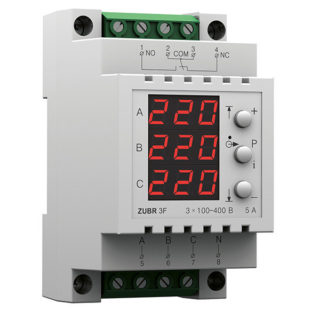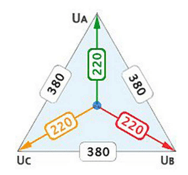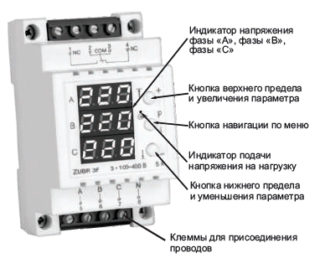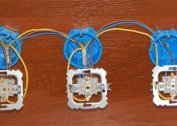There are a wide variety of tools that allow you to control power surges. To control the power use a three-phase voltage relay. If you select and connect the device correctly, tenants will be safe, and property safe.
Appliance use
Three-phase monitoring relays are used to protect the electric motor from the load in everyday life and industrial areas. They help to work correctly:
- air conditioning systems;
- refrigeration equipment;
- compressor installations.
The device is indispensable for any equipment with an ABP circuit and other devices operating on an electromotive load. Helps to avoid emergency situations.
Device features
There are different types of relays. They are produced taking into account the needs of problem networks, in which voltage outages and interference are possible. Devices are able to delay if voltage drops occur.
The three-phase voltage relay is installed in the panel on a special din-rail. It weighs quite a bit and has simple settings.
Installation is carried out parallel to the load, but the work does not depend on power. The relay outputs are equipped with closed and open contact groups, which are independent of each other and switch loads up to 5A.
Principle of operation
The operation of the device is based on the principle of self-return. If an emergency occurs, the equipment is turned off. When a three-phase voltage is applied to the relay, it checks all the parameters. If everything is normal, the built-in electromagnetic device turns on.
If there is a malfunction, the relay turns off, and after returning the parameters to normal, it turns on without delay.
During the entire period of operation, the device monitors the voltage level and turns off the load in case of:
- the disappearance of any phase;
- phase imbalance;
- phase sequence disturbances.
The device is designed to control the quality of electrical energy. It provides reliable protection of equipment against sudden voltage drops in the network.
Connection diagram and installation of a voltage relay
The device will perform its functions regardless of position. But each model has its own connection scheme. It can be seen on the case.
For all devices, there are the same rules that are designed to control the process of connecting the relay to the electrical circuit.
Input contacts to the network are connected through a contactor or starter. Conductors of all phases are combined with the terminals that are located on the top of the device. Elements are marked like this:
- Phase letters A, B and C.
- N - terminal of the neutral wire.
- 1,2,3 - lower terminals.
First, from terminal 1, the conductor is connected to the output of the coil, which is located in the contactor. Terminal 3 is connected to any phase. The second output is connected to the neutral conductor of the three-phase network.
Power elements are connected as follows:
- Each phase that supplies current is connected to the input terminal of the contactor.
- Conductors are connected to the output terminals.
- To connect the neutral conductors, a common zero bus is installed in the distribution panel.
To ensure reliable contact, special tips are used.
RCD connection diagram
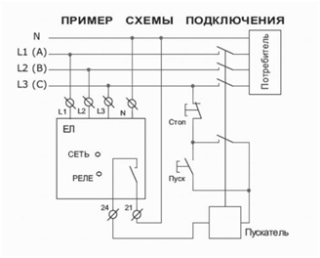 In apartments, connecting a three-phase network is rare. This option is popular for private homes. The protection device in them is connected in several ways:
In apartments, connecting a three-phase network is rare. This option is popular for private homes. The protection device in them is connected in several ways:
- The voltage relay 380 V 2-pole for the house is not suitable. Use 4-pole analogs. They connect 1 zero core and 3 phase. The circuit is complicated by the fact that each line is equipped with its own RCD device. It is important to choose the right wires. For a single-phase network, the standard version of VVG is suitable, but for a 3-phase network, VVGng, resistant to ignition, is needed.
- Total RCD for a 3-phase network + counter. The circuit has an electricity meter. Group RCDs are in the service system of individual lines. This scheme requires the installation of a large electrical panel with many wires and electrical appliances.
If the apartment or house has a large number of lighting and outlet circuits, as well as a variety of household appliances, it is advisable to install double protection with a common RCD.
General three-phase relay settings
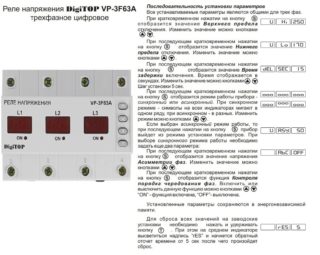 In order for the 3-phase voltage monitoring relay to work, some settings need to be made. After connecting the device to an electric circuit, power is supplied to it, and information appears on the display:
In order for the 3-phase voltage monitoring relay to work, some settings need to be made. After connecting the device to an electric circuit, power is supplied to it, and information appears on the display:
- If the image on the display blinks, this indicates a lack of voltage.
- The appearance of dashes indicates a violation of the alternation of phases or the absence of one.
- If the display blinks for a long time, you should suspect that the contactor is not connected.
You can configure the three-phase voltage monitoring relay with two built-in buttons, they depict triangles. They are located on the right side of the device: the top button with a triangle is up, and the bottom is down. To get the maximum shutdown limit, press the top button. She lingers for a few seconds. After that, a figure with a factory level display appears in the central screen. The button must be pressed until the desired value appears. After settings, the instrument will be automatically programmed for ten minutes.
How to set the time for repeated disconnection
On the right side of the display is a control button with a painted clock. It must be pressed and held until the factory value appears. The time interval is 15 seconds. This means that after normalizing the voltage, the device will turn on the electricity again after this period of time.
Performance can be reduced. Just a few clicks on the upper or lower button to display the necessary parameters.
How to adjust the phase imbalance
To configure, you must simultaneously press both triangular buttons. After that, 50V can be seen on the display. This means that power will not be supplied to the network when the phase imbalance reaches this value. To decrease or increase the parameter, you need to set the time of one of the buttons.
Features of common types of voltage relays
Thanks to the voltage relay during power surges, the device will not burn, the board will not melt, and the motor will not fail. The cost of the devices is considerable, but they pay off. Better to prevent emergencies than buying new equipment.
There are several types of several monitoring relays from different manufacturers on the market. They have the same principle of operation, although the design and set of additional functions may vary.
In modern devices, a digital display is installed. It allows you to monitor the voltage level in three phases. There are also additional settings. With their help regulate the operation of the device and provide simplicity and ease of use.
The three-phase voltage control relay is an indispensable thing in the household. Connect and configure it is not difficult. It takes no more than half an hour, after which all electrical appliances will be protected from voltage surges.
